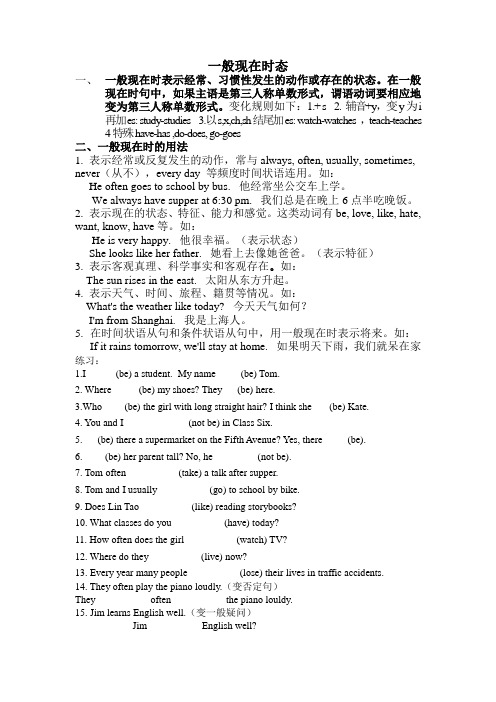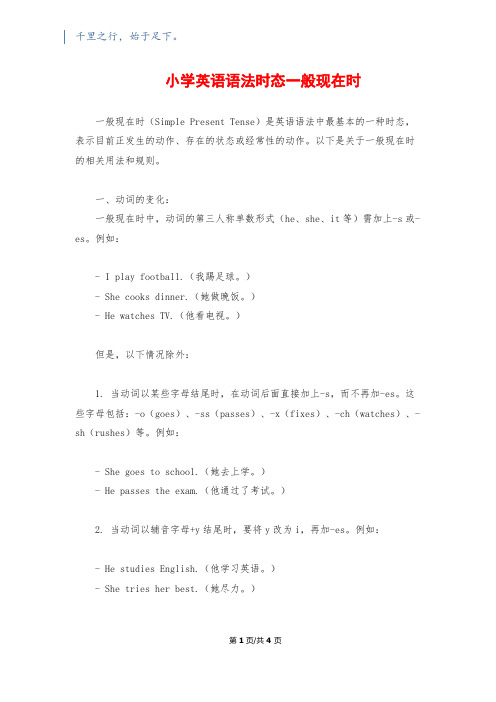一般现在时态
一般现在时态讲解

一般现在时态讲解公司内部档案编码:[OPPTR-OPPT28-OPPTL98-OPPNN08]一般现在时态讲解一般现在时(de)用法:1.表示经常性、习惯性(de)动作或存在(de)状态.eg. I go to school on foot. He is very busy now.2.表示主语(de)特征、性格、能力、爱好等.eg. He can swim. I work hard. I like watching TV.3.表示客观真理 eg. There are seven days in a week. 否定句:主语+be+not+其他 eg. Danny is not a good student. 一般疑问句:Be+主语+其他 eg. Is Danny a good student(2)句中有实意动词,如work, go, get, help, study, play 等表示主语(de)动作肯定句:主语+谓语动词+其他 eg. I work hard at school.否定句:主语+don’t 或doesn ’t+谓语动词原形+其他 eg. I don’t work hard at school.疑问句:Do 或Does + 主语+ 动词原形+其他 eg. Do I work hard at school . They have lunch at 12:00.They don’t have lunch at 12:00. Do they have lunch at 12:00注意:单数第三人称做主语时,谓语动词要用单三形式,变否定句须在动词前加助动词doesn’t;变一般疑问句须在句首加助动词does.. Jenny speaks English very well.Jenny doesn’t speak English very well. Does Jenny speak English very well动词第三人称单数(de)变化规则如下: (1)直接在动词词尾加-s.ask---asks work---works get---gets stay---stays play — plays like — likes(2)以字母s, x, ch, sh 或o 结尾(de)动词,在词尾直接加-es.watch---watches wish---wishes fix---fixesdo---does go---goes pass---passes(3)以“辅音字母加 - y”结尾(de)动词,要先变y 为i 再加-es. try---tries study---studies cry---cries fly---flies (4)不规则变化: have----has一般现在时态(de)时间状语为often、 usually、 always、 sometimes等频率副词,on Saturdays、 in the morning(afternoon evening) 、every day 等.常见错误:be动词与实意动词同时出现在句子中例:We are plant (plant) the trees in spring.(误)正解:We plant (plant) the trees in spring.解析:在英语中,be是表状态,do是表动作,两种动词不能同时出现在句子中,可记住如下口诀:“英汉语言有差异,be 、do不能放一起,仔细琢磨细分析,语法千万要牢记.”一般现在时态练习一般现在时态(de)时间状语为often、 usually、 always、 sometimes,on Saturdays、 in the morning/afternoon/ evening 、every day、every week 等.I.用所给词(de)正确形式填空1. We often___________(play) on the playground.2. He _________(get) up at six o’clock everyday.3. __________you _________(brush) your teeth every morning4. What____ (do) he usually _____(do) after school5. Danny _______(study) English, Chinese, Math, Science and Art atschool.6. Mike sometimes __________(go) to the park with his sister.7. At eight at night, she ________(watch) TV with his parents. 8. ________ Mike________(read) English every day9. How many lessons ______your classmate_______(have) on Monday10. What time _______his mother_________(do) the housework11. He often ______(have) dinner at home.12. Daniel and Tommy________ (be) in Class One.13. We___________________ (not watch) TV on Monday.14. Nick _____________________(not go) to the zoo on Sunday.15. They___________ (like) the World Cup16. What ______they often __________(do) on Sat urdays17. Your parents___________ (read) newspapers every day.18. The girl___________ (teach) us English on Sundays.19. She and I _____________(take) a walk together every evening.20.There____________(be) somewaterin the bottle.21. Mike _____________(like) cooking.22.They____________(have) the same hobby.23. My aunt_____________ (look) after her baby carefully.24. Youalways__________(do) yourhomeworkwell.25. I___________ (be) ill. I’m staying in bed.26.She_________(go) to school from Monday toFriday.27. Liu Tao _________(do) not like PE.28. Thechildoften___________ (watch) TV in the evening.29. Su Hai andSuYang _________(have) eight lessons thisterm.30. -What day _________(be) it today -It’s Saturday.31. Don’t make a noise. Grandpa __________________(sleep).32. Tom’s family__________(watch) TV.33. ---What ______ your mother _______(do) every evening---She _______(wash) clothes.34. _______ it______(rain)every day35. --What _______ you _______(do) on Sundays --We ________ (play) football.36. There ________ (be) a football match on TV every morning.37. They often ________ (visit) the Gre at Wall.38. He _____________ (not come).39. The earth __________ (move) round the sun.40.Mr. Wang often______( go) to Shanghai.Π. 以My School Life为题写一篇小短文,不少于60词.__________________________________________________________________ __________________________________________________________________ __________________________________________________________________ __________________________________________________________________ __________________________________________________________________ __________________________________________________________________ __________________________________________________________________ __________________________________________________________________ __________________________________________________________________ ______________________________________________________。
英语时态:一般现在时

英语时态:一般现在时一、定义一般现在时主要用于表示经常性、习惯性、规律性、客观性(即客观事实、真理)的动作或状态。
一般现在时动作发生的时间是“现在”,动作的状态是“一般”。
(注:“一般”态表示的是“动作经常发生或频繁发生”。
)二、时间状语一般现在时的时间状语主要包括表示频率的副词和时间短语。
(1)常用频度副词:always,usually,often,sometimes,never,rarely(2)常用时间短语:every day/week/month/year每日/周/月/年once a day/week/month/year每天/周/月/年一次in the morning/afternoon/evening在上午/下午/晚上at noon/night在正午/夜里on Sundays在每个星期日三、动词形式主语不是第三人称单数时,谓语动词采用动词原形。
主语为第三人称单数时,谓语动词需采用第三人称单数形式。
动词第三人称单数变化形式主要包括以下几种情况:(1)大多数实义动词直接在词尾加s。
清辅音后加s发音为/s/,浊辅音后加s发音为/z/。
示例:speak-speaks/s/work-works/s/arrive-arrives/z/come-comes/z/(2)以o,s,x,ch,sh结尾的动词在词尾加es。
o后加s发音为/z/,其他几个后面加s发音为/iz/。
示例:do-does/z/go-goes/z/pass-passes/iz/fix-fixes/iz/watch-watches/iz/wash-washes/iz/(3)以辅音加y结尾的动词,把y改成i,再加es,发音为/z/。
(注:元音加y结尾的动词,只加s即可,发音为/z/,如play-plays,stay-stays。
)示例:carry-carries/z/hurry-hurries/z/(4)不规则情况(这类词需单独记忆)。
一般现在时态,现在进行时,一般过去时,一般将来时,现在完成时

一般现在时态,现在进行时,一般过去时,一般将来时,现在完成时一般现在时态,现在进行时,一般过去时,一般将来时,现在完成时话题:时态动词教育学习一.一般现在时用动词原形表示,但单数第三人称后要加-S,在词尾加-s 时要注意:1( 一般情况:加-s 例,reads,writes,says2( 以s,x,ch,sh收尾的词加-es 例:teaches,washes,guesses3( 以辅音字母,y结尾的词变y为I 再加-es 例:try-tries。
Carry-carries。
这个时态的疑问句一般以句首加助动词do,does构成。
句中动词要用原形动词be提前:Do you know it,Are you students,Does she have a pen,1( 一般现在时表示经常性或习惯性的动作:We always carefor each other and help each other.They cycle to work everyday.2( 现在特征或状态:He loves sports.Do you sing? A little.I major in English.3(遍真理Light travels faster than sound.Two and four makes six.The moon moves round see the earth.有些表示状态和感觉的动词常常可用于一般现在时:be love likehate want hope need prefer wish know understand remember believe recognize guess suppose mean belong think feel envydoubt remain consist contain seem look see fit suit owe own hear find suggest propose allow show prove mind have sound taste matter require possess desire等等。
一般现在时态的定义

一般现在时态的定义一般现在时态是英语中最基本的时态之一,用来表示经常性或习惯性的动作、真理、客观事实以及现在的状态等。
在句子中,一般现在时态的动词通常不需要进行时态的变化,而且常常与时间状语连用,以更清晰地表达动作的发生时间。
一般现在时态常用于以下几个方面:1. 表示经常性或习惯性的动作一般现在时态可以用来描述人们的日常生活习惯或经常性的动作。
例如:“I always go to bed early.”(我总是早睡),“She brushes her teeth twice a day.”(她每天刷两次牙)。
2. 表示客观事实或普遍真理一般现在时态还可以用来表达客观事实或普遍真理。
例如:“The sun rises in the east.”(太阳从东方升起),“Water boils at 100 degrees Celsius.”(水在100摄氏度时沸腾)。
3. 表示现在的状态或情况一般现在时态可以用来描述现在的状态或情况。
例如:“I am a student.”(我是一名学生),“The sky is blue.”(天空是蓝色的)。
4. 表示计划或安排的动作一般现在时态还可以用来表示将来的计划或安排的动作。
例如:“We leave for the airport tomorrow.”(明天我们去机场),“The train arrives at 9 o'clock tonight.”(火车今晚9点到达)。
需要注意的是,一般现在时态还可以与一些时间状语连用,以更准确地表达动作的发生时间。
常见的时间状语有:always(总是)、usually(通常)、often(经常)、sometimes(有时候)、never (从不)等。
当我们使用一般现在时态时,还需要注意主语和动词的一致性。
对于第三人称单数的主语,动词的形式要加上-s或-es。
例如:“She loves playing the piano.”(她喜欢弹钢琴)。
一般现在时态

一般现在时态一、一般现在时表示经常、习惯性发生的动作或存在的状态。
在一般现在时句中,如果主语是第三人称单数形式,谓语动词要相应地变为第三人称单数形式。
变化规则如下:1.+ s 2. 辅音+y,变y为i再加es: study-studies 3.以s,x,ch,sh结尾加es: watch-watches , teach-teaches 4特殊have-has ,do-does, go-goes二、一般现在时的用法1. 表示经常或反复发生的动作,常与always, often, usually, sometimes, never(从不),every day 等频度时间状语连用。
如:He often goes to school by bus. 他经常坐公交车上学。
We always have supper at 6:30 pm. 我们总是在晚上6点半吃晚饭。
2. 表示现在的状态、特征、能力和感觉。
这类动词有be, love, like, hate, want, know, have等。
如:He is very happy. 他很幸福。
(表示状态)She looks like her father. 她看上去像她爸爸。
(表示特征)3. 表示客观真理、科学事实和客观存在。
如:The sun rises in the east. 太阳从东方升起。
4. 表示天气、时间、旅程、籍贯等情况。
如:What's the weather like today? 今天天气如何?I'm from Shanghai. 我是上海人。
5.在时间状语从句和条件状语从句中,用一般现在时表示将来。
如:If it rains tomorrow, we'll stay at home. 如果明天下雨,我们就呆在家练习:1.I______(be) a student. My name_____(be) Tom.2. Where _____(be) my shoes? They___(be) here.3.Who ____(be) the girl with long straight hair? I think she ___(be) Kate.4. You and I ____________ (not be) in Class Six.5.___(be) there a supermarket on the Fifth Avenue? Yes, there_____(be).6. ____(be) her parent tall? No, he ____ (not be).7. Tom often __________(take) a talk after supper.8. Tom and I usually __________(go) to school by bike.9. Does Lin Tao __________(like) reading storybooks?10. What classes do you __________(have) today?11. How often does the girl __________(watch) TV?12. Where do they __________(live) now?13. Every year many people __________(lose) their lives in traffic accidents.14. They often play the piano loudly.(变否定句)They __________ often __________ the piano louldy.15. Jim learns English well.(变一般疑问)__________ Jim __________ English well?。
一般现在时态的讲解

一般现在时态的含义
一般现在时态表示现在时间发生的动作或状态,通常与时间状语如always、 usually、often等连用。
它也可以表示未来的情况,特别是当与表示将来的时间状语连用时,如next year、tomorrow等。
一般现在时态的构成
动词be的一般现在时态形式为 am、is、are。
总结词
选择练习是一种有效的巩固一般现在时态的方法,它能够 帮助学生识别和纠正错误。
要点二
详细描述
教师提供一系列句子,每个句子中都有一个动词形式错误 ,学生需要从给定的选项中选择正确的动词形式来纠正句 子。例如,“She ___(go) to the movies every Saturday.”,正确的选项应该是“goes”,因为主语是第 三人称单数,需要用单数形式的动词。通过选择练习,学 生可以加深对一般现在时态规则的理解,并学会在语境中 正确运用。
THANKS
感谢观看
学毕业后将会找到工作。
03
CATALOGUE
一般现在时态与其他时态的对比
与过去时态的对比
过去时态强调动作发生在过去, 与现在时间点不相关;一般现在 时态则表示动作或状态与现事情,一般现在时态则常用于描
述当前情况或习惯性行为。
过去时态需要使用助动词 “did”或“was/were”,而一
详细描述
在填空练习中,教师给出句子,让学生填写 正确的动词形式,以符合一般现在时态的规 则。例如,“I ___(live) in New York.”, 正确的填写应该是“live”,表示现在居住 在纽约。通过这样的练习,学生可以加深对 一般现在时态的理解,并学会在实际语境中 运用。
选择练习
要点一
在时间状语从句和条件状语从句中表示将来
小学英语语法时态一般现在时

小学英语语法时态一般现在时一般现在时(Simple Present Tense)是英语语法中最基本的一种时态,表示目前正发生的动作、存在的状态或经常性的动作。
以下是关于一般现在时的相关用法和规则。
一、动词的变化:一般现在时中,动词的第三人称单数形式(he、she、it等)需加上-s或-es。
例如:- I play football.(我踢足球。
)- She cooks dinner.(她做晚饭。
)- He watches TV.(他看电视。
)但是,以下情况除外:1. 当动词以某些字母结尾时,在动词后面直接加上-s,而不再加-es。
这些字母包括:-o(goes)、-ss(passes)、-x(fixes)、-ch(watches)、-sh(rushes)等。
例如:- She goes to school.(她去上学。
)- He passes the exam.(他通过了考试。
)2. 当动词以辅音字母+y结尾时,要将y改为i,再加-es。
例如:- He studies English.(他学习英语。
)- She tries her best.(她尽力。
)第1页/共4页3. 当动词以-e结尾时,只需加上-s。
例如:- They write letters.(他们写信。
)- He can dance.(他会跳舞。
)二、用法:1. 描述客观事实或经常性动作:一般现在时常用于描述客观事实或经常性动作。
例如:- Water boils at 100 degrees Celsius.(水沸腾的温度是100摄氏度。
)- I usually go to bed at 10 o'clock.(我通常在10点钟上床睡觉。
)2. 描述现阶段的状态:一般现在时还可用来描述现阶段的状态或对现实情况的评论。
例如:- They live in New York.(他们住在纽约。
)- She looks tired.(她看起来很累。
一般现在时态

时态:一般现在时1.一般现在时:表示通常性,规律性,习惯性的动作或者状态。
2.常用的时间状语:often经常,usually 通常,always总是,everyday(week, month, year)每天,每周,每月,每年,once a week 每周一次,sometimes 有时3 构成:动词原形:be 动词(am is are)情态动词(can may must will)行为动词(除了2种)主语是第三人称单数:a直接在动词后面加sb 以y结尾分两种情况,一种y前是元音a e i o u,直接加sy前是辅音要变y 为i加es,如playsc 以s, o, x, ch ,sh 结尾要加es, 如goes, washes, teaches, fixes, kisses4.否定形式:be not情态动词+not助动词do/does + not +行为动词1. We often______(play) in the playgound.2. He _____(get) up at six o’clock.3. _____you ______(brush) your teeth every morning.4. What (do) ______he usually (do)______ after school?5. Danny _____(study) English,Chinese,Maths,Science and Art an school.6. Mike sometimes ________(go) to the park with his sister.7. At eight at night, she __________(watch) TV with his parents.8. ________ Mike________(read) English every day?9. How many lessons_________your classmate________(have) on Monday?10. What time_________his mother_________(do) the housework?。
- 1、下载文档前请自行甄别文档内容的完整性,平台不提供额外的编辑、内容补充、找答案等附加服务。
- 2、"仅部分预览"的文档,不可在线预览部分如存在完整性等问题,可反馈申请退款(可完整预览的文档不适用该条件!)。
- 3、如文档侵犯您的权益,请联系客服反馈,我们会尽快为您处理(人工客服工作时间:9:00-18:30)。
一般现在时的用法(Section One)
1.表示主语现在的状态、存在的情况或状况。
DIG:主语+am/is/are+表语(主系表结构)
Mr Wang is in Beijing. 王先生在北京。
He is twelve. She is at work.
This is a book . They are very busy . It is me.
2.表示人或物现在经常性或习惯性的动作,常与表示频率的时间状语连用。
时间状语:often经常, usually通常, always总是,every week(day, month, year ,morning) 每周(天,月,年,早上), sometimes有时,at…在几点钟,on Sunday
I leave home for school at 7 every morning.
I get up at 6:30 every day.
Tina gets up at six in the morning every day. 蒂娜每天早上六点钟起床。
We always care for each other and help each other.我们总是互相关心,互相帮助。
3.客观真理,客观存在,科学事实或普通真理,表示现状、性质、状态时多用系动词或状态动词。
The earth moves around the sun.
Shanghai lies in the east of China.
The moon moves around the earth. 月球绕着地球转。
Ice feels cold.(冰摸起来很冷。
)
3) 表示格言或警句中。
Pride goes before a fall.骄者必败。
注意:此用法如果出现在宾语从句中,即使主句是过去时,从句谓语也要用一般现在时。
Columbus proved that the earth is round.
4) 表示主语具备的性格和能力等,如:She likes noodles. They speak French.
表示主语具备的特征、性格和能力。
Lily can speak a little Chinese now.
莉莉现在能说一点儿汉语。
现在时刻的状态、能力、性格、个性。
I don't want so much.
Ann Wang writes good English but does not speak well.
比较:Now I put the sugar in the cup.I am doing my homework now.
第一句用一般现在时,用于操作演示或指导说明的示范性动作,表示言行的瞬间动作。
再如:Now watch me, I switch on the current and stand back. 第二句中的now是进行时的标志,表示正在进行的动作的客观状况,所以后句用一般现在时。
一般现在时:表示经常性的事情。
表示知觉、态度、感情、某种抽象的关系或概念的词常用一般现在时:see, hear, smell, feel, notice, agree, believe, like, hate, want, think, belong, seem等。
I know what you mean.(我知道你的意思。
)
一般现在时的用法:
1) 经常性或习惯性的动作,常与表示频度的时间状语连用。
时间状语:often, always, usually, sometimes ,every morning/night/evening/day/week ,twice a week ,never.
如:I read English every morning.
She sometimes goes shopping on Sundays.
2) 客观真理,客观存在,科学事实。
如:The earth moves around the sun.
Shanghai lies in the east of China.
3) 表示格言或警句中。
如:Pride goes before a fall. 骄者必败。
4) 现在时刻的状态、能力、性格、个性。
如:I don't want so much.
He writes good English but does not speak well.
5)倒装句,表示动作正在进行,如:Here comes the bus. = The bus is coming. There goes the bell. = The bell is ringing.
6) 一般现在时Be动词情况:am,is,are也可以做一般现在时的助动词
如:I am a student.。
